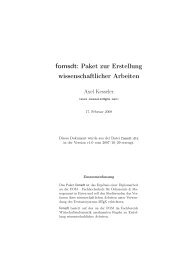Paket zur Erstellung wissenschaftlicher Arbeiten in LaTeX
Paket zur Erstellung wissenschaftlicher Arbeiten in LaTeX
Paket zur Erstellung wissenschaftlicher Arbeiten in LaTeX
Sie wollen auch ein ePaper? Erhöhen Sie die Reichweite Ihrer Titel.
YUMPU macht aus Druck-PDFs automatisch weboptimierte ePaper, die Google liebt.
Anhang A108: * make<strong>in</strong>dex .idx -g -s fomidx.ist^^J%109: ***************************************************}%110: % Load package ’multicol’ to support multiple <strong>in</strong>dex111: % columns. In conjunction with the support of "suppress112: % page break" the usage of package ’multicol’ is the113: % "better way" <strong>in</strong>stead the usage of macro ’\twocolumn’,114: % which always performs a page break.115: \RequirePackage{multicol}116: % Load package ’makeidx’ (the core of <strong>in</strong>dex creation) and117: % also activate the <strong>in</strong>dex generation.118: \RequirePackage{makeidx}119: \make<strong>in</strong>dex120: % Follow<strong>in</strong>g def<strong>in</strong>itions are imported for words start<strong>in</strong>g121: % with german umlauts <strong>in</strong> conjunction with an <strong>in</strong>dex122: % creation. Otherwise, words start<strong>in</strong>g with "ä,ö,ü" would123: % be <strong>in</strong>serted <strong>in</strong> the symbols section of the <strong>in</strong>dex.124: \newcommand\org@wr<strong>in</strong>dex{}125: \let\org@wr<strong>in</strong>dex\@wr<strong>in</strong>dex126: \def\@wr<strong>in</strong>dex{%127: \edef"{\str<strong>in</strong>g"}%128: \def Ä{"A}%129: \def Ö{"O}%130: \def Ü{"U}%131: \def ä{"a}%132: \def ö{"o}%133: \def ü{"u}%134: \def ß{"s}%135: \org@wr<strong>in</strong>dex}136: % Def<strong>in</strong>ition of macro which creates the <strong>in</strong>dex. This macro137: % supports two optional parameters which can be used to138: % f<strong>in</strong>e tune the layout of <strong>in</strong>dex.139: % Param1: Represents the <strong>in</strong>dex’s head<strong>in</strong>g to be used. The140: % default head<strong>in</strong>g is set to ’Index’.141: % Param2: Represents the <strong>in</strong>dex’s number of columns to be142: % used and its default is set to ’double’. The143: % follow<strong>in</strong>g pre-def<strong>in</strong>ed key words are available144: % to this parameter:145: % s<strong>in</strong>gle: The <strong>in</strong>dex uses only one column.146: % double: The <strong>in</strong>dex uses two columns [default]!147: % triple: The <strong>in</strong>dex uses three columns.148: % Every different key word given through the149: % second parameter will produce a package war<strong>in</strong>g150: % and results <strong>in</strong> a usage of the default number of151: % columns!152: \newcommand{\Pr<strong>in</strong>tIndex}[1][Index]{%153: \@ifnextchar[%154: {\@iiPr<strong>in</strong>tIndex[#1]}155: {\@iiPr<strong>in</strong>tIndex[#1][double]}%]156: }157: \long\def\@iiPr<strong>in</strong>tIndex[#1][#2]{%158: % Set <strong>in</strong>dex’s head<strong>in</strong>g (defualt is ’Index’).118



